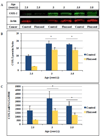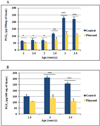Long term consumption of flaxseed enriched diet decreased ovarian cancer incidence and prostaglandin E₂in hens
- PMID: 23707669
- PMCID: PMC3824958
- DOI: 10.1016/j.ygyno.2013.05.018
Long term consumption of flaxseed enriched diet decreased ovarian cancer incidence and prostaglandin E₂in hens
Abstract
Objective: Ovarian cancer is the most lethal gynecological malignancy. Prevention may be the best approach to reduce ovarian cancer. Flaxseed is the richest vegetable source of omega-3 fatty acids which may be effective in the prevention of ovarian cancer. Prostaglandin E₂ (PGE₂) is the most pro-inflammatory ecoisanoid and one of the downstream products of two isoforms of cyclooxygenase (COX) enzymes: COX-1 and COX-2. Our objective was to determine if long-term consumption of a flaxseed enriched diet decreased ovarian cancer severity and incidence in the laying hen and to investigate its potential correlation with the expression of COX enzymes and PGE₂ concentration.
Methods: White Leghorn hens were fed 10% flaxseed-enriched or standard diet for 4years. The severity and incidence of ovarian cancer were determined by gross pathology and histology. COX-1 and COX-2 protein and mRNA expression and PGE₂ concentrations in ovaries were measured by Western blot, quantitative real-time PCR and ELISA, respectively.
Results: The results demonstrated that there was a reduction in ovarian cancer severity and incidence in hens fed flaxseed diet. In correlation with decreased ovarian cancer severity and incidence, concentration of PGE₂ and expression of COX-2 were diminished in ovaries of hens fed flaxseed.
Conclusions: Our findings suggest that the lower levels of COX-2 and PGE₂ are the main contributing factors in the chemo-suppressive role of long-term flaxseed consumption in ovarian cancer in laying hens. These findings may provide the basis for clinical trials of dietary intervention targeting prostaglandin biosynthesis for the prevention and treatment of ovarian cancer.
Keywords: Cyclooxygenase; Flaxseed; Inflammation; Laying hen; Ovarian cancer; Prostaglandin E(2).
Copyright © 2013 The Authors. Published by Elsevier Inc. All rights reserved.
Conflict of interest statement
The authors declare that there are no conflicts of interest.
Figures






Similar articles
-
Flaxseed enriched diet-mediated reduction in ovarian cancer severity is correlated to the reduction of prostaglandin E(2) in laying hen ovaries.Prostaglandins Leukot Essent Fatty Acids. 2013 Sep;89(4):179-87. doi: 10.1016/j.plefa.2013.08.001. Epub 2013 Aug 14. Prostaglandins Leukot Essent Fatty Acids. 2013. PMID: 23978451 Free PMC article. Clinical Trial.
-
Anti-inflammatory effects of fish oil in ovaries of laying hens target prostaglandin pathways.Lipids Health Dis. 2013 Oct 24;12:152. doi: 10.1186/1476-511X-12-152. Lipids Health Dis. 2013. PMID: 24156238 Free PMC article.
-
Age dependent increase in prostaglandin pathway coincides with onset of ovarian cancer in laying hens.Prostaglandins Leukot Essent Fatty Acids. 2012 Dec;87(6):177-84. doi: 10.1016/j.plefa.2012.09.003. Epub 2012 Oct 23. Prostaglandins Leukot Essent Fatty Acids. 2012. PMID: 23089186 Free PMC article.
-
Cyclooxygenase-2 and cancer treatment: understanding the risk should be worth the reward.Clin Cancer Res. 2010 Mar 1;16(5):1384-90. doi: 10.1158/1078-0432.CCR-09-0788. Epub 2010 Feb 23. Clin Cancer Res. 2010. PMID: 20179228 Free PMC article. Review.
-
Influence of Flaxseed (Linum usitatissimum) on Female Reproduction.Planta Med. 2023 May;89(6):608-615. doi: 10.1055/a-2013-2966. Epub 2023 Feb 20. Planta Med. 2023. PMID: 36808094 Review.
Cited by
-
The interaction between epigenetics, nutrition and the development of cancer.Nutrients. 2015 Jan 30;7(2):922-47. doi: 10.3390/nu7020922. Nutrients. 2015. PMID: 25647662 Free PMC article. Review.
-
Evaluating the cytotoxicity of flaxseed orbitides for potential cancer treatment.Toxicol Rep. 2015 Jul 13;2:1014-1018. doi: 10.1016/j.toxrep.2015.06.011. eCollection 2015. Toxicol Rep. 2015. PMID: 28962442 Free PMC article.
-
Flaxseed reduces the pro-carcinogenic micro-environment in the ovaries of normal hens by altering the PG and oestrogen pathways in a dose-dependent manner.Br J Nutr. 2015 May 14;113(9):1384-95. doi: 10.1017/S000711451500029X. Epub 2015 Apr 8. Br J Nutr. 2015. PMID: 25850566 Free PMC article.
-
Flaxseed Mitigates Acute Oxidative Lung Damage in a Mouse Model of Repeated Radiation and Hyperoxia Exposure Associated with Space Exploration.J Pulm Respir Med. 2014;4(6):1000215. doi: 10.4172/2161-105X.1000215. J Pulm Respir Med. 2014. PMID: 25705570 Free PMC article.
-
The Effects of the Dietary and Nutrient Intake on Gynecologic Cancers.Healthcare (Basel). 2019 Jul 7;7(3):88. doi: 10.3390/healthcare7030088. Healthcare (Basel). 2019. PMID: 31284691 Free PMC article. Review.
References
-
- Gupta RA, Tejada LV, Tong BJ, Das SK, Morrow JD, Dey SK, et al. Cyclooxygenase-1 is overexpressed and promotes angiogenic growth factor production in ovarian cancer. Cancer Res. 2003;63:906–911. - PubMed
-
- Urick ME, Johnson PA. Cyclooxygenase 1 and 2 mRNA and protein expression in the Gallus domesticus model of ovarian cancer. Gynecologic Oncology. 2006;103:673–678. - PubMed
Publication types
MeSH terms
Substances
Grants and funding
LinkOut - more resources
Full Text Sources
Other Literature Sources
Medical
Research Materials

